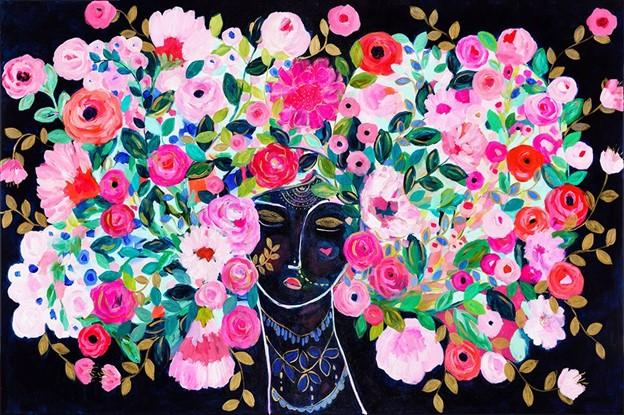'I had to move across America when I became allergic to the sun'
- Published

When Carrie Schmitt's life-threatening heat allergy left her unable to get out of bed she had to give up her job and move across America in search of cooler weather. It also lead her to becoming an artist, as Emily Oomen explores.
On a hot Ohio day in 2003, Carrie was out walking with her young son. As they explored, she started to feel unwell and her legs began to swell.
As they grew to nearly three times their normal size, she called the emergency services and was rushed to hospital with anaphylactic shock.
The doctors treating her were puzzled.
Initially, they suspected the reaction must be down to a bee sting or pollen, but Carrie was tested for both and wasn't allergic to either.
As she recovered she was discharged, but over the next few months, she kept having reactions.
After many tests and consultations, doctors finally settled on a diagnosis: Cholinergic and solar urticaria - Carrie was allergic to heat and the sun.
Carrie, a lover of sunny weather, was devastated. "It was like a death of my old life," she says.

What is Urticaria?
● Urticaria, also known as hives, is an itchy rash that appears on the skin.
● It can be caused by the immune system mistakenly attacking healthy tissue.
● One in seven people with chronic urticaria experience depression or anxiety as a result of the condition
● In many cases, no obvious cause can be found.
Source: NHS

Carrie's allergy had become so severe she could no longer walk up stairs or do any fast movements such as sweeping the floors.
If her body sensed heat it would go into anaphylactic shock.
Dr. Mansi Kanuga, an allergy specialist at the Mayo Clinic, says there are a "variety of theories" about the cause of cholinergic and solar urticaria, but "the specific underlying mechanism is not well understood".
She says: "These disorders probably result from heightened sensitivity by allergy cells (known as mast cells) to environmental conditions or stimuli."
Mast cells are part of the immune system and help fight infection. When they detect an allergen they release histamine.
Carrie's specialist believes Carrie's allergies may be tied to the birth of her son.
Carrie lost a lot of weight while nursing him, and, unlike her other two babies, her son had a voracious appetite and nursed almost constantly. Her body became depleted of nutrients to the point where her hair began to fall out.
She says, doctors believe her body may have felt like it was being attacked and mistakenly tagged heat as the enemy.
As Carrie tried to get her head around the diagnosis she became increasingly frustrated.
The only safe place for her became bed, which she was unable to leave for months.
She says she was lucky, her husband at the time had a good job and health insurance and was able to look after the children, but she struggled to come to terms with her condition.
She often thought: "I can't lay here for 50 years. This cannot be my life.
"One day, a voice popped into my head and said: 'Now that your life is over, why don't you do what you want and paint?'"
Carrie had always loved art but had given it up as a teenager, swayed by others to pursue a more secure career.

Prior to her heat allergy, she had worked as a medical writer at Cincinnati Children's Hospital where she wrote for medical journals, textbooks and the hospital's website.
But when she painted, "it just took me to this other realm where my physical condition didn't matter," she says.
"I couldn't wait to wake up in the morning and paint. It's all I wanted to do. I developed a really beautiful relationship with creativity because it saved me."
Carrie was able to sit up in bed and balance her sketchbook on her knees and surround herself with all the materials she needed.
She describes herself as an "intuitive painter", letting the painting emerge without a plan, which she says creates something "bigger than I could imagine".
Her paintings are colourful and feature a lot of flowers, harking back to her family's history as gardeners.
While Carrie started to paint, she was also trying different treatments.
Cholinergic and solar urticaria is often managed by minimising exposures to triggers such as hot baths and direct sunlight. Antihistamines can also be useful in reducing itching and hives.
But Carrie found her allergy didn't respond well to traditional treatments and started to explore more holistic approaches including advanced allergy therapeutics (AAT).
AAT involves placing pads on the body and applying gentle pressure. It is similar to acupuncture, but no needles are involved.
Dr. Kanuga says, at the moment, AAT is not a studied approach to the management of allergies.
Carrie was sceptical as a result, but said after the treatments the improvement was "so immediate, it shocked me".
She was able to get out of bed and walk, she could drive again and take the stairs. She would occasionally get a rash, but the reactions were reduced.
There was another, more drastic, treatment her doctors suggested she could benefit from, but it would be life-changing - move from Ohio, where temperatures can reach highs of 38C (100F), to a more temperate climate.
Carrie decided to take the plunge and moved to rainy Seattle where highs are generally around 21C (70F).
With the cooler environment, Carrie began to see gradual improvements in her condition until she was able to do yoga and paint beyond her bedroom.

She began searching for a studio, but after coming up against Seattle's exorbitant property prices she bought a school bus, painted it pink, named it Rosie and turned it into an art space.
"It turned out to be one of the best blessings in my life," Carrie says.
While Carrie has more freedom in Seattle, she still must be careful with Washington's increasingly warm summers and wildfires. When the summers are too hot, she must find shelter in air-conditioned hotel rooms or cabins on cooler islands.
She admits managing the condition can be difficult at times. She misses out on her children's sports games when it is too hot and she relies on her family to help with groceries and household chores that require too much movement.
But there are positives too. It has led her to write her memoir - The Story of Every Flower - about her artwork and she is teaching art classes online in the hope of inspiring others to embrace creativity at difficult times.
"I feel like it can be your ally, or your friend, or your beloved," she says. "It's always there."
